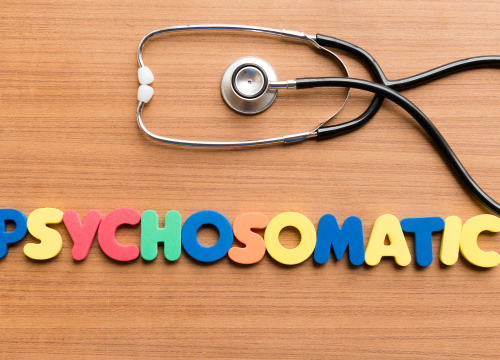Difference Between Somatic and Psychosomatic
Somatic is part of the term, somatic symptom disorder, which is a condition where people worry too much over physical symptoms. Psychosomatic is the disorder where people have physical symptoms that are caused by stress rather than an underlying medical problem.

What is Somatic?
Definition:
Somatic is a word that means body, and a somatic symptom disorder is when a person spends an excessive length of time worried about their physical symptoms.
Causes:
Scientists do not know what exactly causes somatic symptom disorder, but the theory is that it is a result of a combination of genetics and environmental factors.
Symptoms:
The person spends a lot of time pre-occupied about their physical symptoms and shows high levels of anxiety over their physical condition.
Diagnosis:
Somatic disorder is diagnosed by the person displaying symptoms such as excessive worry for 6 months or more. The concern and pre-occupation that the person is having with their symptoms is out of proportion to the problem that they are having. A visit to a physician and mental health provider is the best way to diagnose the condition.
Treatment:
The patient can be helped by advising them to get psychotherapy and by them visiting their primary care physician.

What is Psychosomatic?
Definition:
Psychosomatic is a word used to describe the condition when a person has so much emotional stress that this is shown physiologically.
Causes:
Psychosomatic problems are caused when people are exposed to too much stress or experience very high levels of depression or anxiety. Mental conditions such as anxiety disorders and depression may be partly a result of genetics, which when combined with environmental stresses can potentially result in psychosomatic disorders.
Symptoms:
The symptoms of a psychosomatic condition vary and may include digestive system problems, high blood pressure, tension headaches, migraines, and respiratory problems. The symptoms do not have any physical cause despite medical tests being done. The symptoms often abate somewhat once the emotional stress has been alleviated. For example, a person may experience hypertension when very angry, but blood pressure normalizes once they calm down.
Diagnosis:
The diagnosis is of a psychosomatic disorder is done when medical tests fail to show any underlying medical reason for the symptoms that the person is experiencing. The person also shows high levels of psychological distress and may be depressed or anxious.
Treatment:
Medication can be used to treat the symptoms. Antidepressants can be helpful. Cognitive behavioral therapy can also help patients to cope with the stress in their lives.
Difference between Somatic and Psychosomatic?
Definition
A somatic symptom disorder is when a person spends a lot of their time excessively concerned about their physical symptoms. A psychosomatic condition is when a person has physical symptoms, but these are a result of mental anguish and stress rather than an underlying medical problem.
Cause is a medical problem
In the case of somatic symptom disorder, the person may or may not have a real medical condition. In the case of psychosomatic disorder, the person never has an underlying medical condition but rather a mental problem.
Symptoms
The symptoms of somatic disorder include excessive worry over health and the perceived symptoms that the person has; the worry is out of proportion to the physical symptoms. The symptoms of psychosomatic disorder vary and may include migraine, tension headache, breathing problems, and digestive issues.
Complications
Somatic symptom disorder can result in difficulty functioning in everyday life due to constant worry over symptoms. Psychosomatic disorder can result in persistence of the symptoms if the person does not get treatment.
Treatment
In the case of somatic symptom disorder, psychotherapy and cognitive behavioral therapy can be helpful in treating patients with somatic disorder; medication may be prescribed if the person is depressed. In the case of psychosomatic disorder, medication can be given to control underlying mental problems like anxiety and depression, and psychotherapy and cognitive behavioral therapy can help.
Table comparing Somatic and Psychosomatic

Summary of Somatic and Psychosomatic
- Somatic and psychosomatic disorders can be disabling and require mental health treatments like psychotherapy and cognitive behavioral therapy.
- Somatic symptom disorder patients do sometimes have underlying medical conditions.
- Patients with psychosomatic disorder don’t have an underlying medical reason for their symptoms.
FAQ
What is the difference between psychosomatic and somatoform disorders?
Psychosomatic illnesses are never caused by an underlying medical condition.
What is an example of a psychosomatic illness?
High blood pressure is an example of a psychosomatic illness.
What are the 5 somatic disorders?
The 5 somatic disorders are body dysmorphic disorder, hypochondriasis, conversion disorder, pain disorder, and somatization disorder.
What triggers psychosomatic disorder?
The main triggers of psychosomatic disorders are mental and emotional problems, such as depression, stress, and worry.
What is the most common somatic symptom?
The most common somatic symptom is feeling pain somewhere in the body.
Is PTSD a somatic disorder?
PTSD is currently classified as a trauma-related disorder, and not specifically as a somatic disorder.
- Difference Between Rumination and Regurgitation - June 13, 2024
- Difference Between Pyelectasis and Hydronephrosis - June 4, 2024
- Difference Between Cellulitis and Erysipelas - June 1, 2024
Search DifferenceBetween.net :
Leave a Response
References :
[0]Kurlansik, Stuart L., and Mario S. Maffei. "Somatic symptom disorder." American family physician 93.1 (2016): 49-54A.
[1]Sirri, Laura, and Giovanni A. Fava. "Diagnostic criteria for psychosomatic research and somatic symptom disorders." International Review of Psychiatry 25.1 (2013): 19-30.
[2]The Editors of Encyclopedia Britannica. “Psychosomatic disorder”. Encyclopedia Britannica, 2023, https://www.britannica.com/science/psychosomatic-disorder
[3]Image credit: https://www.canva.com/photos/MADAVAaUyd8-psychosomatic/
[4]Image credit: https://www.canva.com/photos/MAFekp2XW6Y-girl-have-mental-breakdown-and-crying-young-woman-have-a-visit-with-female-doctor-in-modern-clinic/
